On January 19, 2018 I heard a fascinating report on National Public
Radio about "Jane", a women's collective that provided abortions in
Chicago when abortion was still illegal. "Jane" was a network of women
-- housewives, students and the like -- who trained themselves to
perform abortions and offered their services to women who had few other
options when confronted with an unwanted pregnancy. They performed the
procedures in rented apartments throughout the city. According to the
NPR report, during the seven years that Jane was active, 11,000 first
and second trimester abortions were performed. Though some women ended
up in the emergency room (including those who had to undergo
hysterectomies), no deaths were ever reported of women who had abortions
through Jane. Members of Jane risked arrest as they served poor, often
desperate women, including
working women who were already struggling to feed the children they
had.
"I don't think anyone chooses to have an abortion
lightly" said Martha Scott, one of the members of Jane. I am amazed by the
willingness of members of "Jane" to take risks on behalf of women they
didn't know. They walked with these women in their existential pain of facing an unwanted pregnancy. "Jane" members risked arrest, the possibility of medical complications, and censure of family and friends.
Having come of age during the second wave of feminism, my
first political activism was passing out leaflets at my
high school supporting the legalization of abortion. That was in
1972. A year later, when the Supreme Court legalized abortion, "Jane" disbanded. Yet the fight for safe and legal abortion for all women continues. On this 45th year-plus one month anniversary of Roe V. Wade, I salute the
women of "Jane" and their remarkable courage!
To me, the women of "Jane" embody the energy of Kali. The Black Goddess Kali in Indian mythology is
both a giver of life and a destroyer. In her poem "Invocation to Kali"
May Sarton wrote:
"It is time for the invocation, to atone
For what we fear most and have not dared to face:
Kali, the destroyer, cannot be overthrown;
We may stay, open-eyed, in the terrible place."
Thursday, February 22, 2018
Friday, November 23, 2007
Summer 2007 Trip to France -- Notes on a Spiritual Journey
Marianne Cotter
Notre Dame de Paris -- the premier church in Paris. Dad, Carl and I headed there on our first day in Paris (a ten minute walk from our hotel). The line to get in was very long, so we walked around the outside and visited a museum which honored the memory of the 200,000 French citizens who died in concentration camps in World War II. Dad and Carl then returned to the hotel and I went into Notre Dame alone. The splendid darkness of the cathedral drew me in and along with pilgrims and tourists from all over the world I marveled at the stained glass, statues and architecture.


I was drawn to the banks of votive candles. Mom used to light candles like this in churches. I lit a candle and prayed for Camden Schara, a 9 year old parishioner in Marshall recently diagnosed with leukemia.
The next day, after finishing a boat ride on the Seine, Dad led us to a walk along the Rue de Rivoli where we did some shopping. We came upon the statue of the Protestant reformer Gaspard de Coligny (1519-1572). (Paris has over 100 churches and only about seven are Protestant.) Coligny was a Huguenot leader who fought for the rights of Protestants to worship freely. The Biblical reference is to Hebrews 11:27: “By faith he left Egypt, not fearing the king's anger; he persevered because he saw him who is invisible.” (New International Version)

Walking farther along the Rue de Rivoli we came to a plaza with a statue of Joan of Arc/Jeanne d’Arc (1412-1431). As a teenager, Joan received a vision from God, led her countrymen into battle against the English, was declared a heretic at the age of 19 and was burned at the stake. Twenty four years later she was declared innocent and a martyr and in 1920 was canonized as a saint. Dad remembered this statue from previous trips with Mom. We sat down at a cafe across from this statue and revived ourselves with coffee (Dad), ice cream (Carl) and a glass of beer (Marianne).
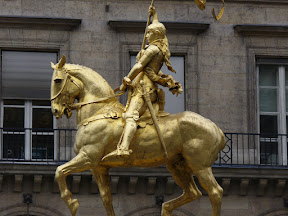
The entrance to the Louvre Museum (former palace of the kings of France) is recognizable to millions of readers of The Da Vinci Code (and those who saw the movie). Carl and I visited the Louvre together one afternoon when the lines were shorter (Dad begged off, having visited there many times before and walking through big museums was hard on his legs). After going our separate ways and visiting galleries that interested us for about an hour and half, Carl and I met up in the cafe. Carl calmly informed me had seen everything worth seeing (everything he cared to see). I was aghast. This is the largest collection of art in the world and he had seen it all in an hour and half? I insisted he stay at least one more hour (we met later in the Tuileries Gardens adjacent to the Louvre, where Carl had walked and photographed flowers).

Here is a selection of the flower pictures Carl took on our trip. Each day in Paris Carl had at least an hour to walk back to our hotel alone after sightseeing for the most of the day. Though relieved always to see him at the end of the day, I felt it was important that at 16 (almost 17) he have some independence to see the bit of the city on his own. He spent much of this time at his favorite spots: the formal gardens of Paris.

The Church of St. Suplice also figures in Dan Brown’s The Da Vinci Code. These pictures show the dark interior of that church (including a mural by Delacroix). Another church we visited was Saint Severin in the Latin Quarter, a short walk from our hotel (no pictures of this one) . Dad and I were there around noon and suddenly singing could be heard. A noon day service was being conducted. The worshippers were a mix of older women, working people, well-dressed professionals and students. The congregation members joined in animated conversation afterwards. The churches of Europe are beautiful yet few have vibrant, active worshipping communities. To keep the faith alive, what is needed are people who will live their faith and pass it on to others.

We stayed at the Hotel de Jardin de Cluny, about three blocks from the “Musee National du Moyen-Age” Museum of the Middle Ages (Cluny Museum). There was a school for young children across the street and every day I enjoyed watching the parents drop off and pick up their kids from the balcony of our room. There was cable TV. Carl enjoyed watching sports programming from Britain and France in the evenings while I read Cold Sassy Tree (a novel about life and faith in the south in the early 1900’s), lent to me by a parishioner Tim Schultz.
On our last morning in Paris I insisted on taking Carl to see Saint Chapelle. I distinctly remember my mother taking Liz and me to Saint Chapelle on a previous trip to Paris (probably in the summer of 1968). In my office at Marshall United Methodist Church, I still have a little statue of St. Louis IX (1215-1270), known for his piety and kindness towards the poor. Louis IX built Saint Chapelle as his private chapel, to house the relics he purchased from the Holy Land. There are two levels to Saint Chapelle. The lower level with gold-covered low gothic arches was where the commoners were allowed to worship once a month. The upper level, accessible by a winding, narrow stone stair case, opened up into a large room with stained glass on all four sides going all the way up to the ceiling. The windows each tell the story of a book in the Bible. I was fascinated by the books that were chosen to depict. Few of the Hebrew prophets were included yet Esther and Job plus Judith and Tobit from the apocrypha were included. The sheer stunning beauty of the stained glass was worth contemplating for a long time. I sat on one of the uncomfortable folding chairs lining the wall at Saint Chapelle and took in the ambiance until I started feeling guilty and gave up my seat to another waiting tourist/pilgrim and found the exit to leave.
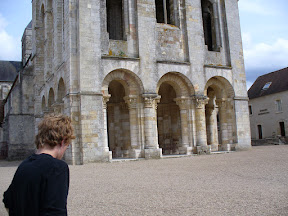
Upon our arrival by train at the station in Orleans to visit our friends Burt and Helen Wyss, Burt whisked us back to Les Chaumettes (their home in Sigloy). Then he surprised us with a tour of a remarkable site. I had no idea a trip to Saint Benoit-sur-Loire would be on our itinerary. Located along the Loire river, this stark simple church was an early Benedictine monastery. After Benedict’s death word came to the monks here that his grave was not being properly cared for. So the monks went to Italy, collected the remains of their spiritual father and brought them back here and placed them in the crypt of this church which is where they remain to this day. On Sunday, July 1st we worshipped here at Saint Benoit-sur-Loire. The bulletin printed the scripture readings for the day. I was pleased to see the monks there used the Revised Common Lectionary (a standard cycle of Bible readings used by Protestants and Catholics worldwide) . As the service began the monks in their brown habits filed in slowly and filled the choir stalls at the front of the church. One part of the Mass was chanted by the monks. For me the most touching part of the worship was at Communion, when an elderly balding monk with a long scraggly white beard slowly led the people from the back of the sanctuary up to the altar. The old women, the babies, the old men, the young urban types, they all were led up to the front to eat and drink in memory of Jesus.

When I came to France, I knew I’d want to bring back a souvenir from Chartres so I saved some of my money to spend there. I knew about the labyrinth at Chartres and was looking forward to seeing it close up. What I was not prepared for was the overwhelming beauty, power and sacredness of the cathedral. Burt, Dad and Carl allowed me to explore Chartres by myself for about 3 and a half hours.
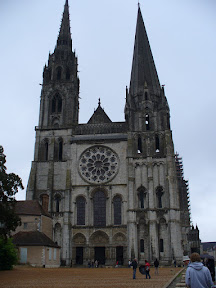
The stained glass windows were absolutely incredible. The vivid colors of the glass crafted in the middle ages (many of which had been restored recently) was remarkable. I purchased an audio guide which gave me a broad overview. Then I began walking the periphery of the cathedral, stopping to contemplate the statues, glass panels and views that caught my attention. I was charmed by the depiction of four of the four gospel writers Matthew, Mark, Luke and John sitting on the shoulders of four of the Hebrew prophets. Sitting at the center of the cross which defines the shape of all medieval churches, I realized this was the most beautiful place I had ever been in my life! I was so grateful Carl was having a chance to visit this awesome place. I prayed a prayer thanking God that I was not born blind that I could come here and see its beauty! Approaching the ambulatory I was delighted by the series of 40 statues lining the outside of the choir depicting different aspects of the life of Christ. I had no idea that stone could be made so lifelike! The adoration of the Magi showed a very stocky, realistic (French-looking) king on bent knee worshipping the squiggling, happy faced Jesus on Mary’s knee. My favorite of these statues was the one of the Ascension, where you could only see his feet, the rest of Jesus’ body having disappeared above. Of course in this era the stained glass and statues were the primary form of religious education for most of the population. And what a religious education you would receive if you studied all the statues (inside and out) and the stained glass of Chartres! (In the 13th century Chartres was a great center of learning and known for it’s school as well as the cathedral.)
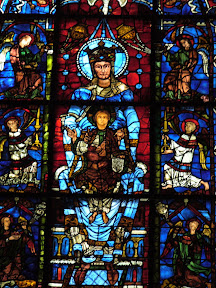
As I began my counterclockwise walk around the ambulatory (top of the church) to the right was The Blue Virgin, a depiction of the Mary with the infant Jesus seated on her lap in brilliant blues and reds. To the left of the Blue Virgin is a window depicting the various astrological signs, along with scenes of the work done in the seasons corresponding to these astrological signs. There is also a curious astrological clock directly across from the Blue Virgin on the outside of the choir.
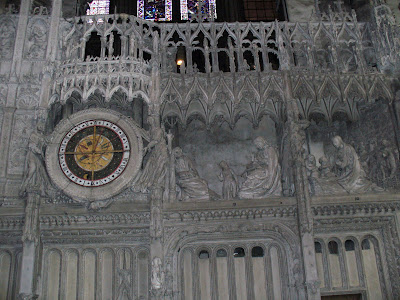
As Jean Markale points out in his book Cathedral of the Black Madonna: The Druids and the Mysteries of Chartres everything at Chartres has two layers of meaning: one that is public (exoteric) and one that is hidden (esoteric). Which brings me to the high point of my trip to Chartres -- discovering the Madonna of the Pillar (the Black Madonna).
As I rounded the ambulatory and headed back towards the entrance of the church, I saw her -- the Black Madonna.
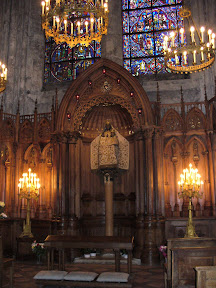
She was encased in a satin, embroidered gown (though a lit display showed what she looked like without this fancy garb. There were wooden benches in front of the statue and I sat down to marvel at her. The Black Madonna has been a subject of interest to me for many years. Found in churches throughout Europe (especially France), Black Madonnas are the darkened statues of Mary with the infant Jesus. Many scholars say these harken back to pre-Christian worship of a mother goddess. As a figure in the history of religion, The Black Madonna represents the feminine principle in Jungian: receptivity, the physical as opposed to spiritual or mental aspects of life, the unconscious, connection to the earth, and that which cannot be named or controlled by (male) orthodoxy.

Walking back I lit one of the votive candles in honor of the person in my life who embodies the virtues and charism of the Black Madonna more than anyone I know : my husband Jim. Jim knows the value of waiting. He is not afraid of the darkness that he sees in other people and can listen sympathetically, empathetically better than anyone else I know. He wields a kind of quiet power: the power of being with. He is able to be receptive. He is practical and down to earth. He is humble and does not need to be the center of attention. He has little interest in speculations about theology and feels that can detract from the real work of religion and faith: helping others, being kind, doing what is right, following “The Jesus Way”.

Later, after doing more reading about Chartres upon my return home, I was able to name what I sensed so powerfully in that cathedral: the presence of the feminine. This whole cathedral is dedicated to Mary, and commemorates the assumption of Mary into heaven where she is crowned Queen of Heaven by her Son and reigns with him in majesty. As Henry Adams points out in his book Mont Saint Michel and Chartres, devotion to Mary was the impetus for the rapid rebuilding of the cathedral after a fire in 1194. During the crusades, devotion to Mary took on a new intensity and it was this veneration of Mary that inspired the building of the great French cathedrals of the middle ages. I could well imagine the common folk of the 13th century, with the hard lives they led, coming to this place of beauty and grace and pouring out their tales of suffering to the Blessed Mother. She -- like any good mother -- could listen and understand their trials. Surely she would intercede for them with her Son.
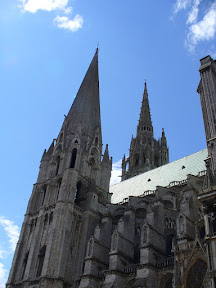
Was Chartres built over the site of a pre-Christian well marking a place where the goddess was worshipped long before the Christians came here? It seems so. It is alluring to many to speculate on the mystical and and esoteric aspects of Chartres and the Black Madonna. Yet these can lead us away from the Black Madonna and Mary’s true role: to bring us to her Son, who alone has the power to save us.
Which brings me to the final chapter of my spiritual journey to France. Present with us on this trip every step of the way was the memory of my mother. When my father first contacted me in late May, 2007 asking if I’d like to go along on the trip he and my son Carl were planning to France, I immediately thought of my mother. It was she who first guided me on my previous visits to Europe (in 1964, 1968, 1970 and 1973). With her guidebook in hand, she toured the great museums and churches with my sister and I, read to us about the saints depicted in the paintings, explaining the Biblical allusions in the church art we saw. With my mother gone, it would now be up to me to be the tour guide. Would I be up to the challenge? As we walked the streets of Paris my father would often comment “this is a church Harva and I went to” or “this is the cafe that Harva and I stopped at when we came to Paris for the day in 2002”. Spending a final evening with Burt and Helen Wyss, who actually knew my mom longer than I did, we reminisced about Mom and kept her memory alive among us. As an atheistic Jew by birth but never by choice, Mom did not believe in the after life. Jews primarily believe that immortality is experienced in the memories of the deceased that are kept alive by their living relatives. In this way on this trip especially, Mom achieved immortality because we all thought and talked about her a lot.
When I came to faith as a Christian in my adult years, I looked back on my turbulent teenage years and thought about the role my mother played during that time. There was a period of my life for about two years where I was quite troubled emotionally and did some things which caused both my parents concern, even alarm. During that difficult time my mother was Christ to me. Before I ever heard of Jesus Christ, I experienced the love Christ has for us through my mother. It was a compassionate “being with,” suffering with the other. It was a love that doesn’t give up, a love that forgives and holds out hope that the person will one day truly be what God intends them to be. It was a love that sticks by you and doesn’t give up. In a way my mother did what the Black Madonna of Chartres (or anywhere else) should ideally do: bring us to the saving knowledge of God in Jesus Christ. Years later my conversion was made easier because of what my mother had done for me.
One final footnote: This trip to France was a gift and a surprise. As I said, I did not expect to go along on this trip my Dad had planned with my son. I was sitting on the couch at home reading a book about sharing the gospel with others Unbinding the Gospel by Martha Grace Reese and I got a call from my Dad inviting me to go along. From that day, my mind and free time was occupied with planning various aspects of the trip. Now that I’ve returned home my focus is again on how I can help people share the good news about Jesus. As I think back on my trip, the one image I’m left with is the image I have framed and hung over my stove in my kitchen. It is the sixth of a series of tapestries depicting The Lady and the Unicorn. Dating from the late 1400’s, discovered in the mid 19th century and restored, these remarkable tapestries are on display at the Cluny Museum (Musee de Moyen Age) which was three blocks from our hotel. My father and I spent the morning at the museum and later I went back alone for another visit. I do not have any pictures of the tapestries at the of the Lady and the Unicorn but they can be viewed by going to “http://en.wikipedia.org/wiki/The_Lady_and_the_Unicorn”. The first five in the series depict the five senses --taste, hearing, sight, smell, and touch. In each scene the lady is seen accompanied by the unicorn and the lion along with food, a musical instrument, mirror, flowers and the lady touching the unicorn’s horn to reflect these different senses. that The final tapestry shows the lady putting the necklace she has worn in the other tapestries away in a box. The scene is entitled “My Sole Desire.”
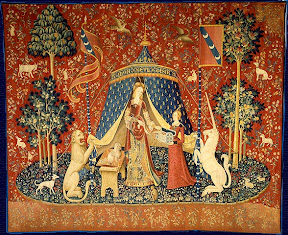
Interpretations vary. What is the Lady’s sole desire? Is she renouncing the life of the senses? Is she affirming her virginity? Does this sixth tapestry refer to her sixth sense -- intellectual understanding? Whatever the original intention of the tapestry, the challenge remains for each of us to ask ourselves “what is our sole desire?” What do we want above everything else? Travel to beautiful places is a privilege. Fine French meals with choice wines is a wonderful treat. Conversation with longtime friends and family over extended meal times are all to be treasured. The chance to see and experience firsthand some of the places where European history was made is an honor. To hear an organ being played at Chartres cathedral surrounded by the incredible beauty of that place is an experience I will not forget. Smelling the flowers growing in a garden of long-time family friends at a French farm house -- and being taught their names by my son Carl - was a delight and joy.
Yet when I am pressed to name “my sole desire” -- what I long for above everything else -- I hope the true answer of my heart would be Jesus Christ, who loves us all even more than our earthly mothers and fathers and opens to us a world of riches beyond imagining.
Marianne Hachten Cotter
November 4, 2007
Marianne Cotter
Notre Dame de Paris -- the premier church in Paris. Dad, Carl and I headed there on our first day in Paris (a ten minute walk from our hotel). The line to get in was very long, so we walked around the outside and visited a museum which honored the memory of the 200,000 French citizens who died in concentration camps in World War II. Dad and Carl then returned to the hotel and I went into Notre Dame alone. The splendid darkness of the cathedral drew me in and along with pilgrims and tourists from all over the world I marveled at the stained glass, statues and architecture.
I was drawn to the banks of votive candles. Mom used to light candles like this in churches. I lit a candle and prayed for Camden Schara, a 9 year old parishioner in Marshall recently diagnosed with leukemia.
The next day, after finishing a boat ride on the Seine, Dad led us to a walk along the Rue de Rivoli where we did some shopping. We came upon the statue of the Protestant reformer Gaspard de Coligny (1519-1572). (Paris has over 100 churches and only about seven are Protestant.) Coligny was a Huguenot leader who fought for the rights of Protestants to worship freely. The Biblical reference is to Hebrews 11:27: “By faith he left Egypt, not fearing the king's anger; he persevered because he saw him who is invisible.” (New International Version)
Walking farther along the Rue de Rivoli we came to a plaza with a statue of Joan of Arc/Jeanne d’Arc (1412-1431). As a teenager, Joan received a vision from God, led her countrymen into battle against the English, was declared a heretic at the age of 19 and was burned at the stake. Twenty four years later she was declared innocent and a martyr and in 1920 was canonized as a saint. Dad remembered this statue from previous trips with Mom. We sat down at a cafe across from this statue and revived ourselves with coffee (Dad), ice cream (Carl) and a glass of beer (Marianne).
The entrance to the Louvre Museum (former palace of the kings of France) is recognizable to millions of readers of The Da Vinci Code (and those who saw the movie). Carl and I visited the Louvre together one afternoon when the lines were shorter (Dad begged off, having visited there many times before and walking through big museums was hard on his legs). After going our separate ways and visiting galleries that interested us for about an hour and half, Carl and I met up in the cafe. Carl calmly informed me had seen everything worth seeing (everything he cared to see). I was aghast. This is the largest collection of art in the world and he had seen it all in an hour and half? I insisted he stay at least one more hour (we met later in the Tuileries Gardens adjacent to the Louvre, where Carl had walked and photographed flowers).
Here is a selection of the flower pictures Carl took on our trip. Each day in Paris Carl had at least an hour to walk back to our hotel alone after sightseeing for the most of the day. Though relieved always to see him at the end of the day, I felt it was important that at 16 (almost 17) he have some independence to see the bit of the city on his own. He spent much of this time at his favorite spots: the formal gardens of Paris.
The Church of St. Suplice also figures in Dan Brown’s The Da Vinci Code. These pictures show the dark interior of that church (including a mural by Delacroix). Another church we visited was Saint Severin in the Latin Quarter, a short walk from our hotel (no pictures of this one) . Dad and I were there around noon and suddenly singing could be heard. A noon day service was being conducted. The worshippers were a mix of older women, working people, well-dressed professionals and students. The congregation members joined in animated conversation afterwards. The churches of Europe are beautiful yet few have vibrant, active worshipping communities. To keep the faith alive, what is needed are people who will live their faith and pass it on to others.
We stayed at the Hotel de Jardin de Cluny, about three blocks from the “Musee National du Moyen-Age” Museum of the Middle Ages (Cluny Museum). There was a school for young children across the street and every day I enjoyed watching the parents drop off and pick up their kids from the balcony of our room. There was cable TV. Carl enjoyed watching sports programming from Britain and France in the evenings while I read Cold Sassy Tree (a novel about life and faith in the south in the early 1900’s), lent to me by a parishioner Tim Schultz.
On our last morning in Paris I insisted on taking Carl to see Saint Chapelle. I distinctly remember my mother taking Liz and me to Saint Chapelle on a previous trip to Paris (probably in the summer of 1968). In my office at Marshall United Methodist Church, I still have a little statue of St. Louis IX (1215-1270), known for his piety and kindness towards the poor. Louis IX built Saint Chapelle as his private chapel, to house the relics he purchased from the Holy Land. There are two levels to Saint Chapelle. The lower level with gold-covered low gothic arches was where the commoners were allowed to worship once a month. The upper level, accessible by a winding, narrow stone stair case, opened up into a large room with stained glass on all four sides going all the way up to the ceiling. The windows each tell the story of a book in the Bible. I was fascinated by the books that were chosen to depict. Few of the Hebrew prophets were included yet Esther and Job plus Judith and Tobit from the apocrypha were included. The sheer stunning beauty of the stained glass was worth contemplating for a long time. I sat on one of the uncomfortable folding chairs lining the wall at Saint Chapelle and took in the ambiance until I started feeling guilty and gave up my seat to another waiting tourist/pilgrim and found the exit to leave.
Upon our arrival by train at the station in Orleans to visit our friends Burt and Helen Wyss, Burt whisked us back to Les Chaumettes (their home in Sigloy). Then he surprised us with a tour of a remarkable site. I had no idea a trip to Saint Benoit-sur-Loire would be on our itinerary. Located along the Loire river, this stark simple church was an early Benedictine monastery. After Benedict’s death word came to the monks here that his grave was not being properly cared for. So the monks went to Italy, collected the remains of their spiritual father and brought them back here and placed them in the crypt of this church which is where they remain to this day. On Sunday, July 1st we worshipped here at Saint Benoit-sur-Loire. The bulletin printed the scripture readings for the day. I was pleased to see the monks there used the Revised Common Lectionary (a standard cycle of Bible readings used by Protestants and Catholics worldwide) . As the service began the monks in their brown habits filed in slowly and filled the choir stalls at the front of the church. One part of the Mass was chanted by the monks. For me the most touching part of the worship was at Communion, when an elderly balding monk with a long scraggly white beard slowly led the people from the back of the sanctuary up to the altar. The old women, the babies, the old men, the young urban types, they all were led up to the front to eat and drink in memory of Jesus.
When I came to France, I knew I’d want to bring back a souvenir from Chartres so I saved some of my money to spend there. I knew about the labyrinth at Chartres and was looking forward to seeing it close up. What I was not prepared for was the overwhelming beauty, power and sacredness of the cathedral. Burt, Dad and Carl allowed me to explore Chartres by myself for about 3 and a half hours.
The stained glass windows were absolutely incredible. The vivid colors of the glass crafted in the middle ages (many of which had been restored recently) was remarkable. I purchased an audio guide which gave me a broad overview. Then I began walking the periphery of the cathedral, stopping to contemplate the statues, glass panels and views that caught my attention. I was charmed by the depiction of four of the four gospel writers Matthew, Mark, Luke and John sitting on the shoulders of four of the Hebrew prophets. Sitting at the center of the cross which defines the shape of all medieval churches, I realized this was the most beautiful place I had ever been in my life! I was so grateful Carl was having a chance to visit this awesome place. I prayed a prayer thanking God that I was not born blind that I could come here and see its beauty! Approaching the ambulatory I was delighted by the series of 40 statues lining the outside of the choir depicting different aspects of the life of Christ. I had no idea that stone could be made so lifelike! The adoration of the Magi showed a very stocky, realistic (French-looking) king on bent knee worshipping the squiggling, happy faced Jesus on Mary’s knee. My favorite of these statues was the one of the Ascension, where you could only see his feet, the rest of Jesus’ body having disappeared above. Of course in this era the stained glass and statues were the primary form of religious education for most of the population. And what a religious education you would receive if you studied all the statues (inside and out) and the stained glass of Chartres! (In the 13th century Chartres was a great center of learning and known for it’s school as well as the cathedral.)
As I began my counterclockwise walk around the ambulatory (top of the church) to the right was The Blue Virgin, a depiction of the Mary with the infant Jesus seated on her lap in brilliant blues and reds. To the left of the Blue Virgin is a window depicting the various astrological signs, along with scenes of the work done in the seasons corresponding to these astrological signs. There is also a curious astrological clock directly across from the Blue Virgin on the outside of the choir.
As Jean Markale points out in his book Cathedral of the Black Madonna: The Druids and the Mysteries of Chartres everything at Chartres has two layers of meaning: one that is public (exoteric) and one that is hidden (esoteric). Which brings me to the high point of my trip to Chartres -- discovering the Madonna of the Pillar (the Black Madonna).
As I rounded the ambulatory and headed back towards the entrance of the church, I saw her -- the Black Madonna.
She was encased in a satin, embroidered gown (though a lit display showed what she looked like without this fancy garb. There were wooden benches in front of the statue and I sat down to marvel at her. The Black Madonna has been a subject of interest to me for many years. Found in churches throughout Europe (especially France), Black Madonnas are the darkened statues of Mary with the infant Jesus. Many scholars say these harken back to pre-Christian worship of a mother goddess. As a figure in the history of religion, The Black Madonna represents the feminine principle in Jungian: receptivity, the physical as opposed to spiritual or mental aspects of life, the unconscious, connection to the earth, and that which cannot be named or controlled by (male) orthodoxy.
Walking back I lit one of the votive candles in honor of the person in my life who embodies the virtues and charism of the Black Madonna more than anyone I know : my husband Jim. Jim knows the value of waiting. He is not afraid of the darkness that he sees in other people and can listen sympathetically, empathetically better than anyone else I know. He wields a kind of quiet power: the power of being with. He is able to be receptive. He is practical and down to earth. He is humble and does not need to be the center of attention. He has little interest in speculations about theology and feels that can detract from the real work of religion and faith: helping others, being kind, doing what is right, following “The Jesus Way”.
Later, after doing more reading about Chartres upon my return home, I was able to name what I sensed so powerfully in that cathedral: the presence of the feminine. This whole cathedral is dedicated to Mary, and commemorates the assumption of Mary into heaven where she is crowned Queen of Heaven by her Son and reigns with him in majesty. As Henry Adams points out in his book Mont Saint Michel and Chartres, devotion to Mary was the impetus for the rapid rebuilding of the cathedral after a fire in 1194. During the crusades, devotion to Mary took on a new intensity and it was this veneration of Mary that inspired the building of the great French cathedrals of the middle ages. I could well imagine the common folk of the 13th century, with the hard lives they led, coming to this place of beauty and grace and pouring out their tales of suffering to the Blessed Mother. She -- like any good mother -- could listen and understand their trials. Surely she would intercede for them with her Son.
Was Chartres built over the site of a pre-Christian well marking a place where the goddess was worshipped long before the Christians came here? It seems so. It is alluring to many to speculate on the mystical and and esoteric aspects of Chartres and the Black Madonna. Yet these can lead us away from the Black Madonna and Mary’s true role: to bring us to her Son, who alone has the power to save us.
Which brings me to the final chapter of my spiritual journey to France. Present with us on this trip every step of the way was the memory of my mother. When my father first contacted me in late May, 2007 asking if I’d like to go along on the trip he and my son Carl were planning to France, I immediately thought of my mother. It was she who first guided me on my previous visits to Europe (in 1964, 1968, 1970 and 1973). With her guidebook in hand, she toured the great museums and churches with my sister and I, read to us about the saints depicted in the paintings, explaining the Biblical allusions in the church art we saw. With my mother gone, it would now be up to me to be the tour guide. Would I be up to the challenge? As we walked the streets of Paris my father would often comment “this is a church Harva and I went to” or “this is the cafe that Harva and I stopped at when we came to Paris for the day in 2002”. Spending a final evening with Burt and Helen Wyss, who actually knew my mom longer than I did, we reminisced about Mom and kept her memory alive among us. As an atheistic Jew by birth but never by choice, Mom did not believe in the after life. Jews primarily believe that immortality is experienced in the memories of the deceased that are kept alive by their living relatives. In this way on this trip especially, Mom achieved immortality because we all thought and talked about her a lot.
When I came to faith as a Christian in my adult years, I looked back on my turbulent teenage years and thought about the role my mother played during that time. There was a period of my life for about two years where I was quite troubled emotionally and did some things which caused both my parents concern, even alarm. During that difficult time my mother was Christ to me. Before I ever heard of Jesus Christ, I experienced the love Christ has for us through my mother. It was a compassionate “being with,” suffering with the other. It was a love that doesn’t give up, a love that forgives and holds out hope that the person will one day truly be what God intends them to be. It was a love that sticks by you and doesn’t give up. In a way my mother did what the Black Madonna of Chartres (or anywhere else) should ideally do: bring us to the saving knowledge of God in Jesus Christ. Years later my conversion was made easier because of what my mother had done for me.
One final footnote: This trip to France was a gift and a surprise. As I said, I did not expect to go along on this trip my Dad had planned with my son. I was sitting on the couch at home reading a book about sharing the gospel with others Unbinding the Gospel by Martha Grace Reese and I got a call from my Dad inviting me to go along. From that day, my mind and free time was occupied with planning various aspects of the trip. Now that I’ve returned home my focus is again on how I can help people share the good news about Jesus. As I think back on my trip, the one image I’m left with is the image I have framed and hung over my stove in my kitchen. It is the sixth of a series of tapestries depicting The Lady and the Unicorn. Dating from the late 1400’s, discovered in the mid 19th century and restored, these remarkable tapestries are on display at the Cluny Museum (Musee de Moyen Age) which was three blocks from our hotel. My father and I spent the morning at the museum and later I went back alone for another visit. I do not have any pictures of the tapestries at the of the Lady and the Unicorn but they can be viewed by going to “http://en.wikipedia.org/wiki/The_Lady_and_the_Unicorn”. The first five in the series depict the five senses --taste, hearing, sight, smell, and touch. In each scene the lady is seen accompanied by the unicorn and the lion along with food, a musical instrument, mirror, flowers and the lady touching the unicorn’s horn to reflect these different senses. that The final tapestry shows the lady putting the necklace she has worn in the other tapestries away in a box. The scene is entitled “My Sole Desire.”

Interpretations vary. What is the Lady’s sole desire? Is she renouncing the life of the senses? Is she affirming her virginity? Does this sixth tapestry refer to her sixth sense -- intellectual understanding? Whatever the original intention of the tapestry, the challenge remains for each of us to ask ourselves “what is our sole desire?” What do we want above everything else? Travel to beautiful places is a privilege. Fine French meals with choice wines is a wonderful treat. Conversation with longtime friends and family over extended meal times are all to be treasured. The chance to see and experience firsthand some of the places where European history was made is an honor. To hear an organ being played at Chartres cathedral surrounded by the incredible beauty of that place is an experience I will not forget. Smelling the flowers growing in a garden of long-time family friends at a French farm house -- and being taught their names by my son Carl - was a delight and joy.
Yet when I am pressed to name “my sole desire” -- what I long for above everything else -- I hope the true answer of my heart would be Jesus Christ, who loves us all even more than our earthly mothers and fathers and opens to us a world of riches beyond imagining.
Marianne Hachten Cotter
November 4, 2007
Subscribe to:
Posts (Atom)
